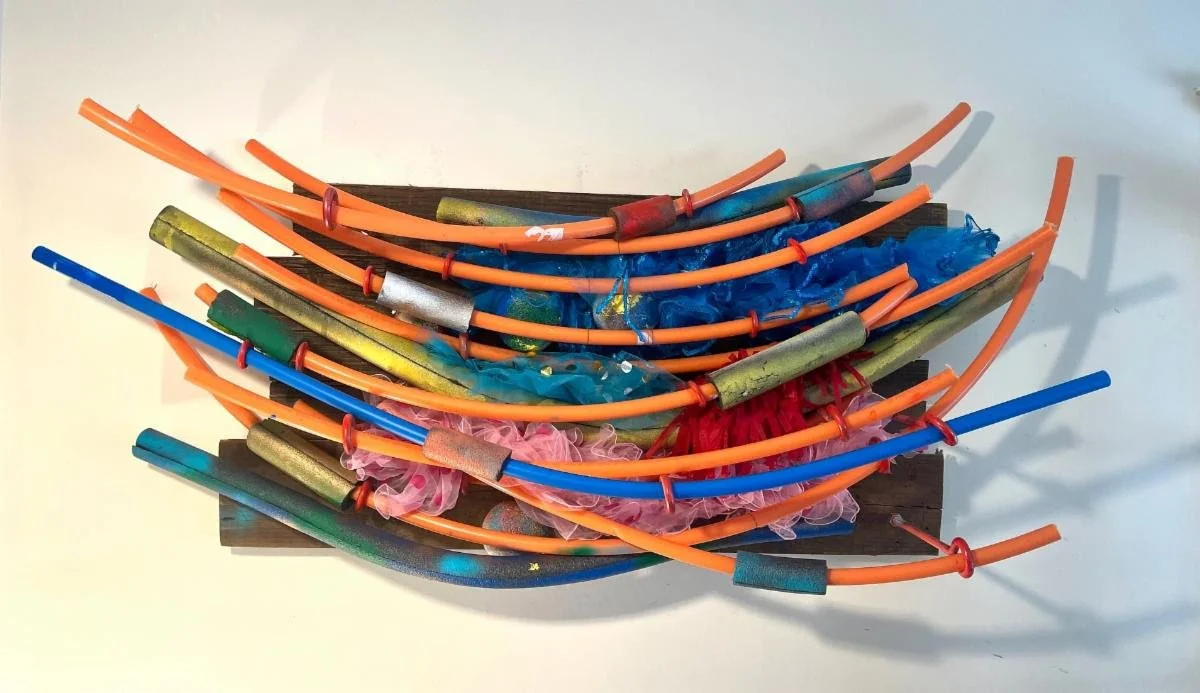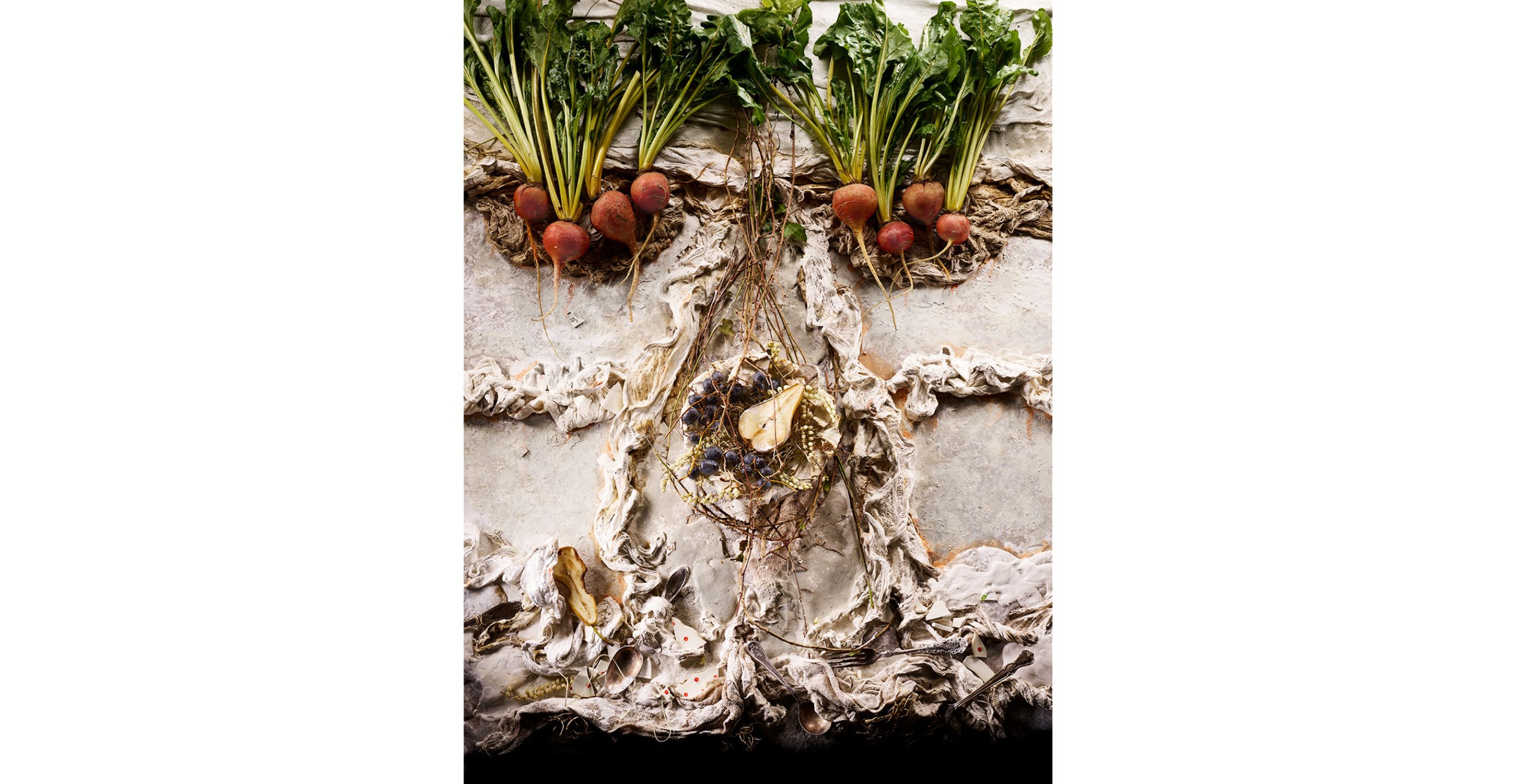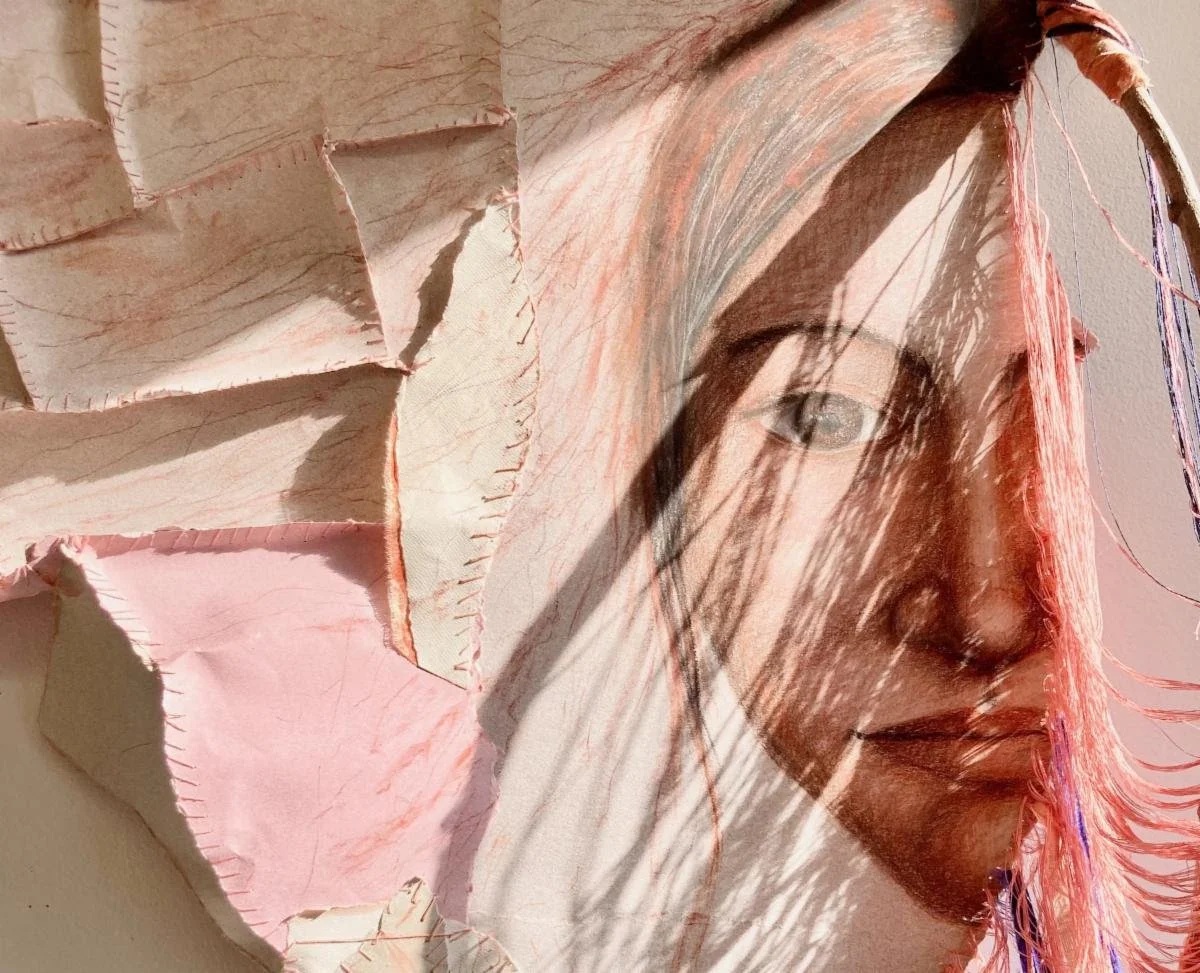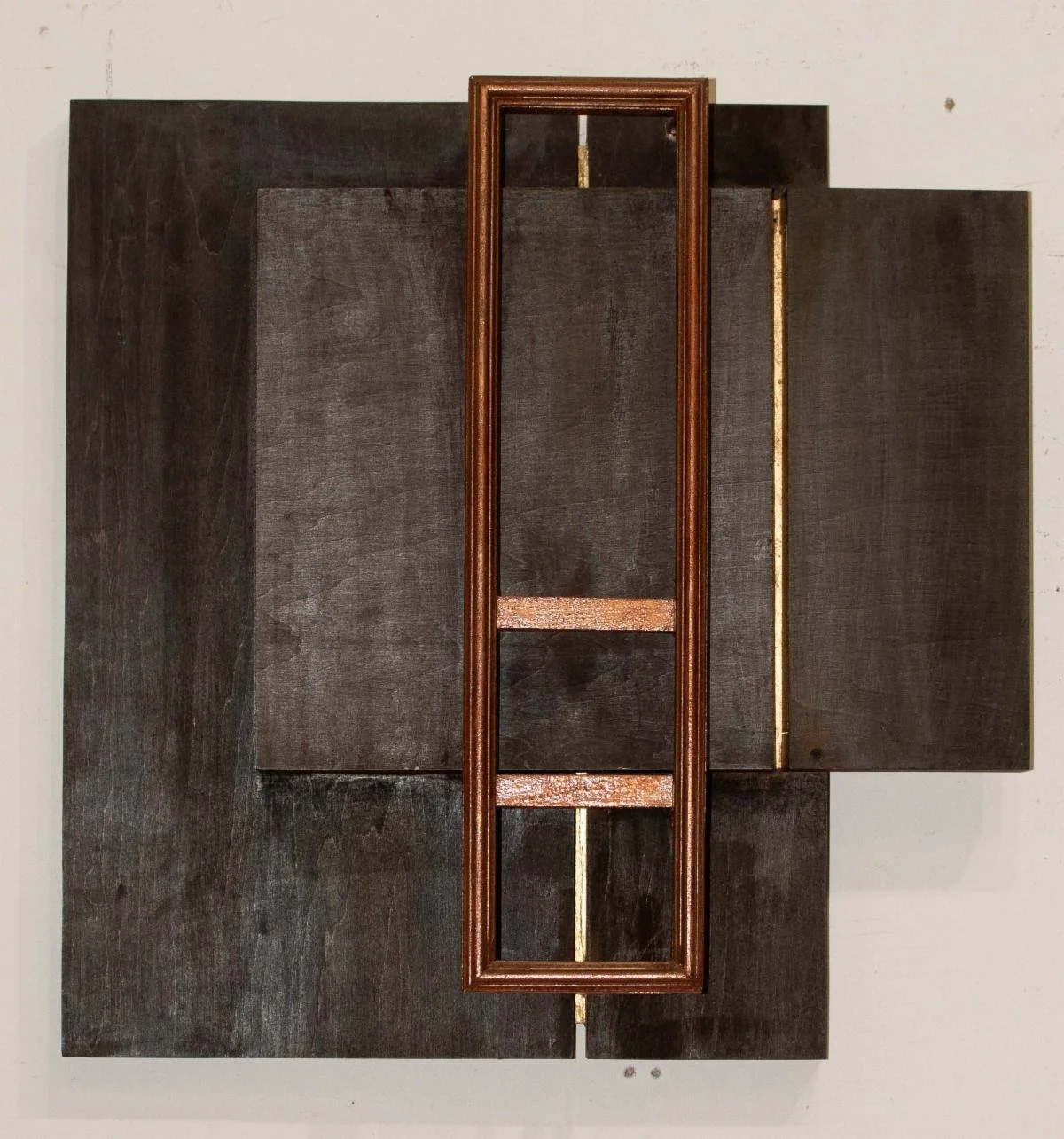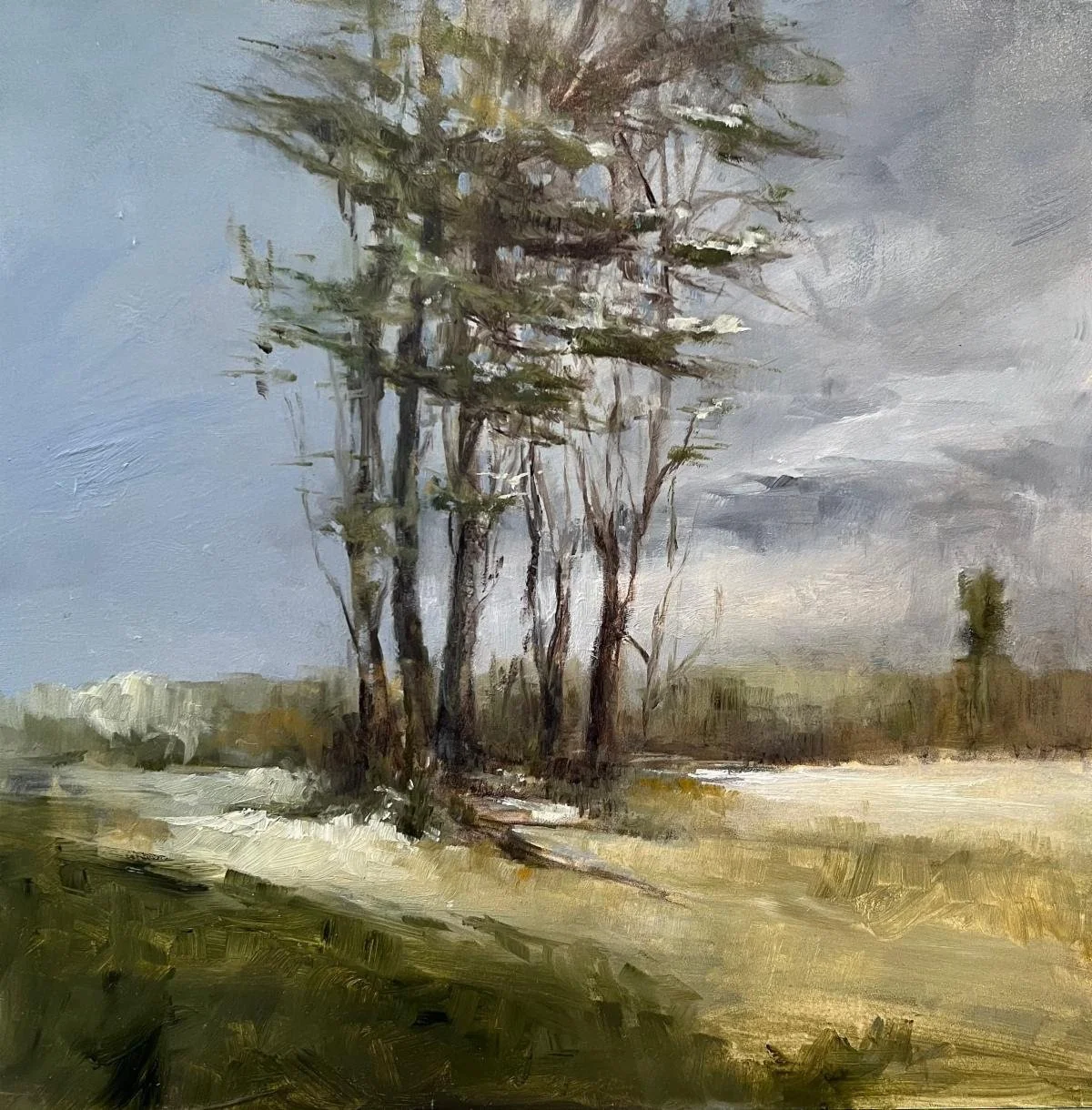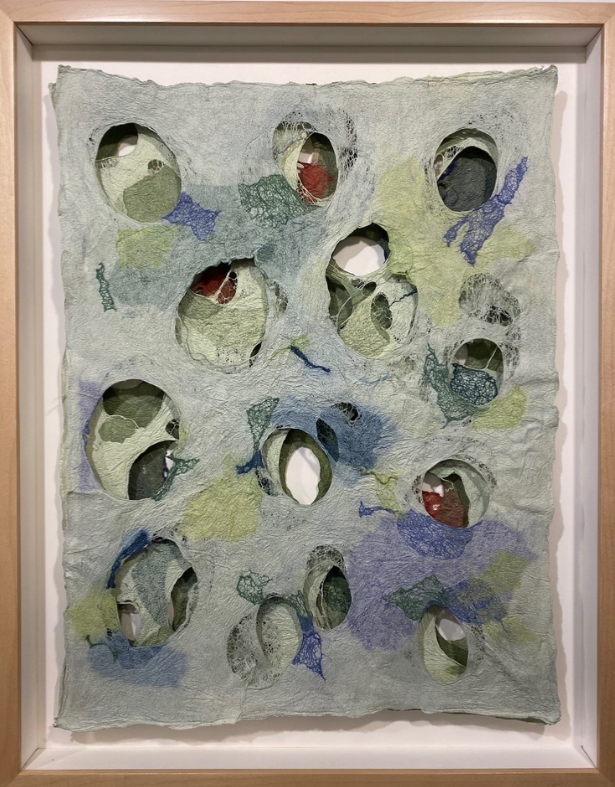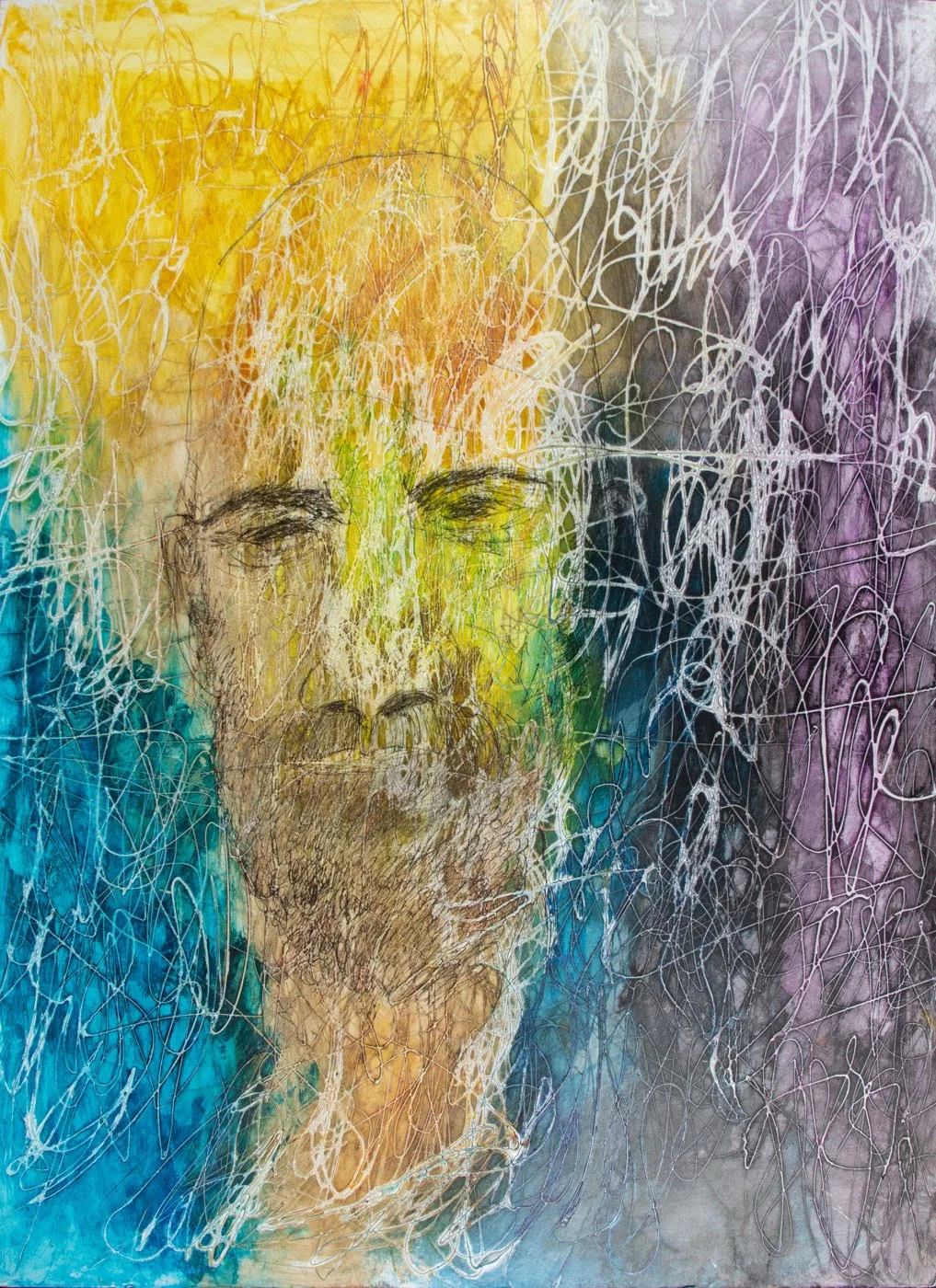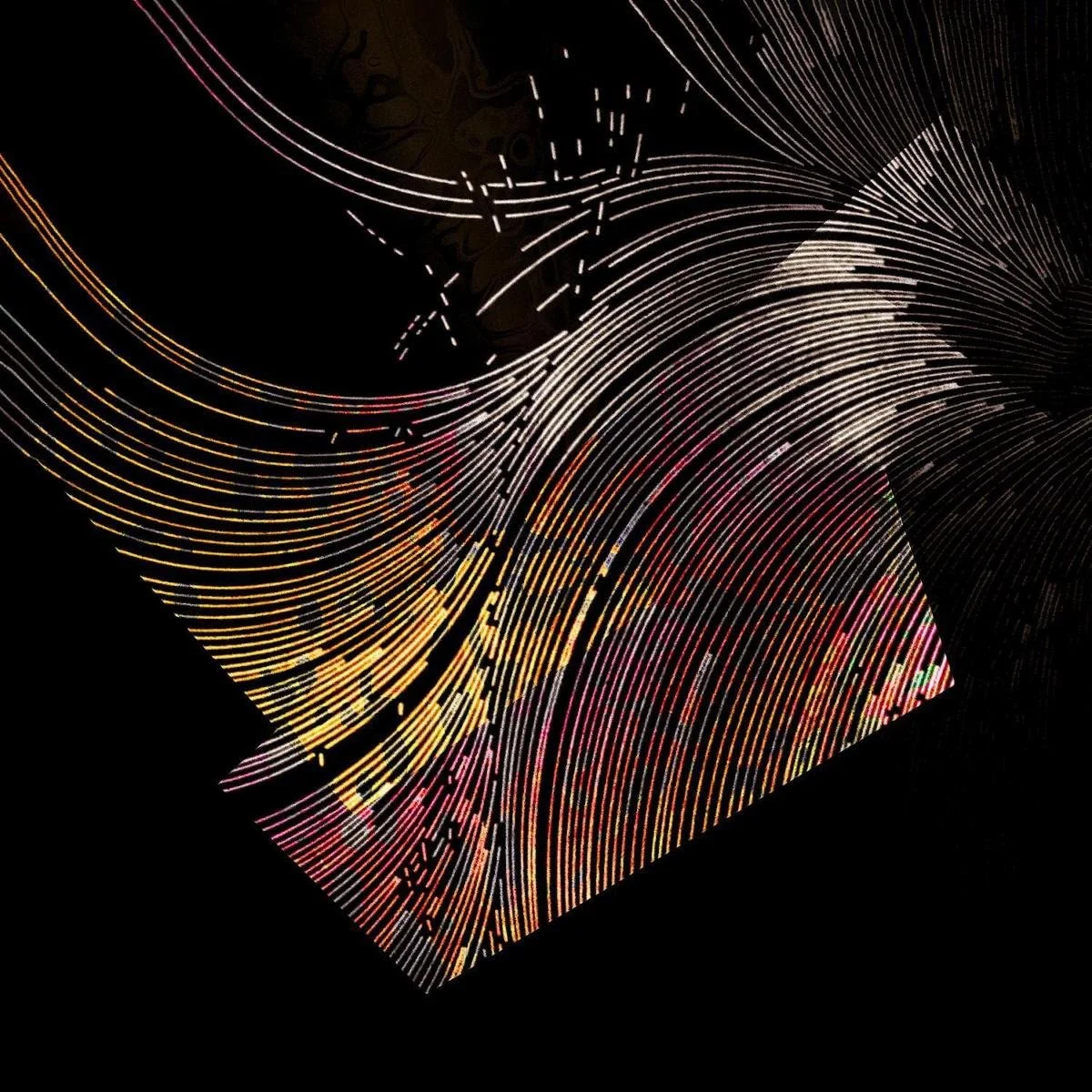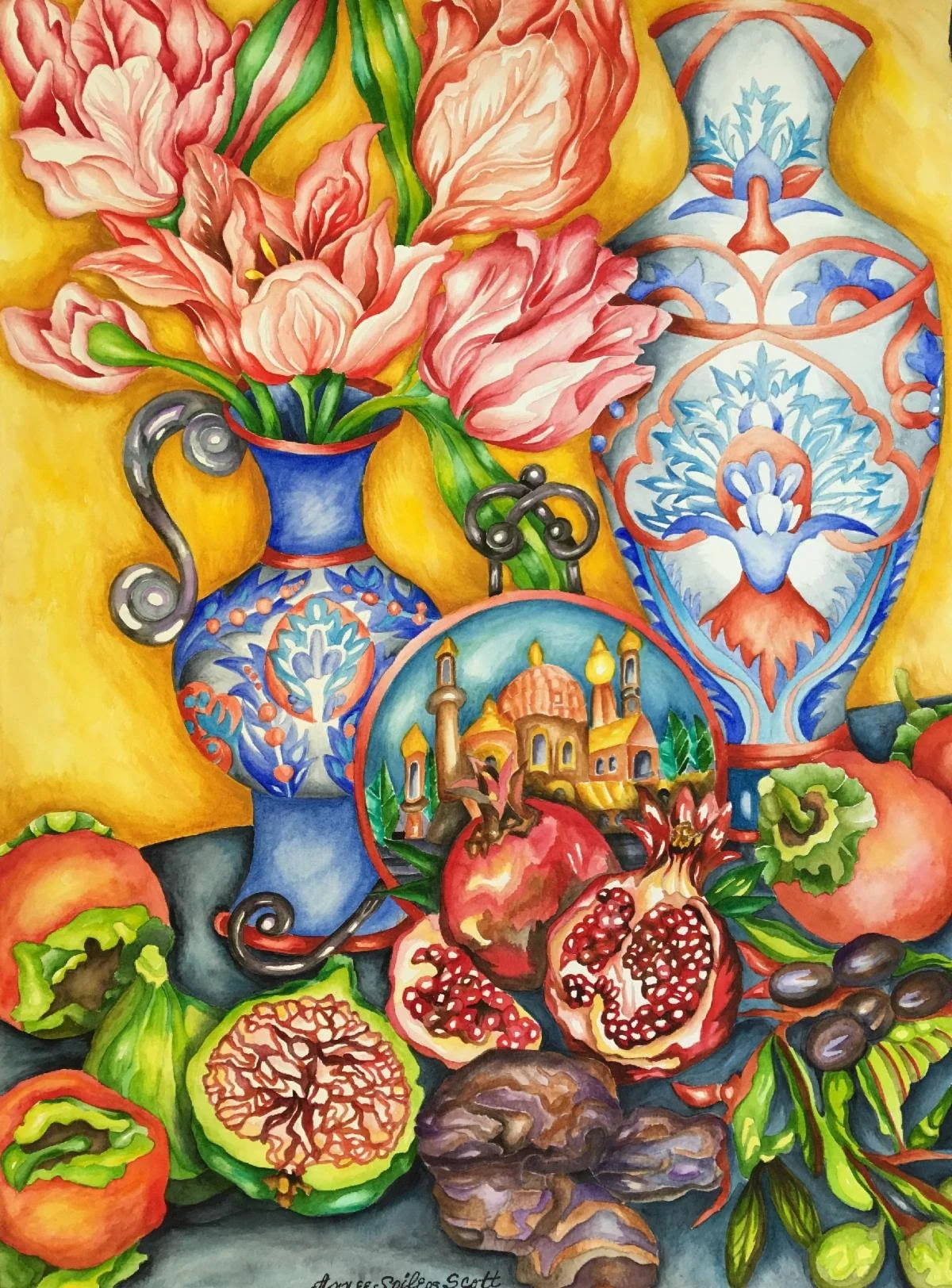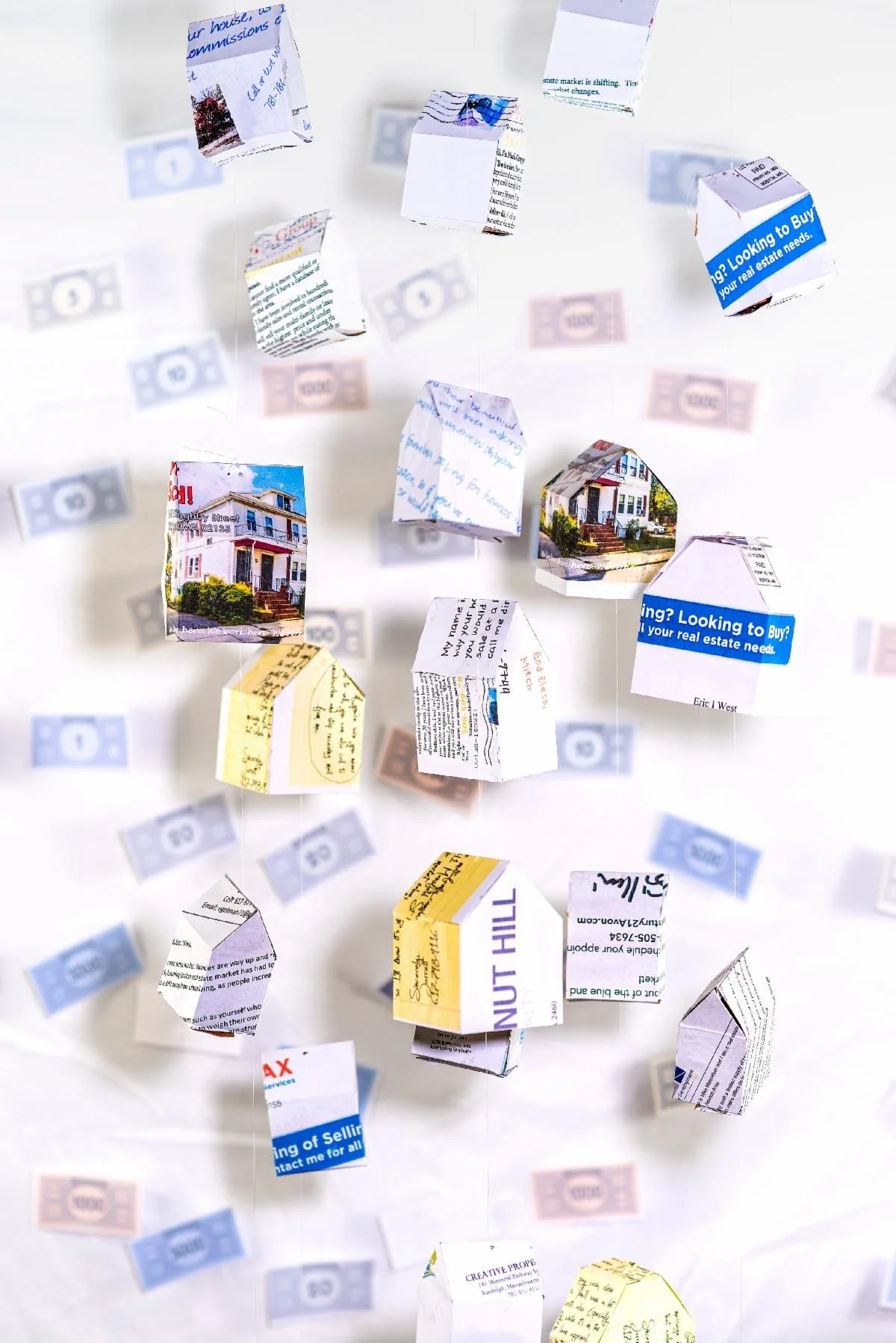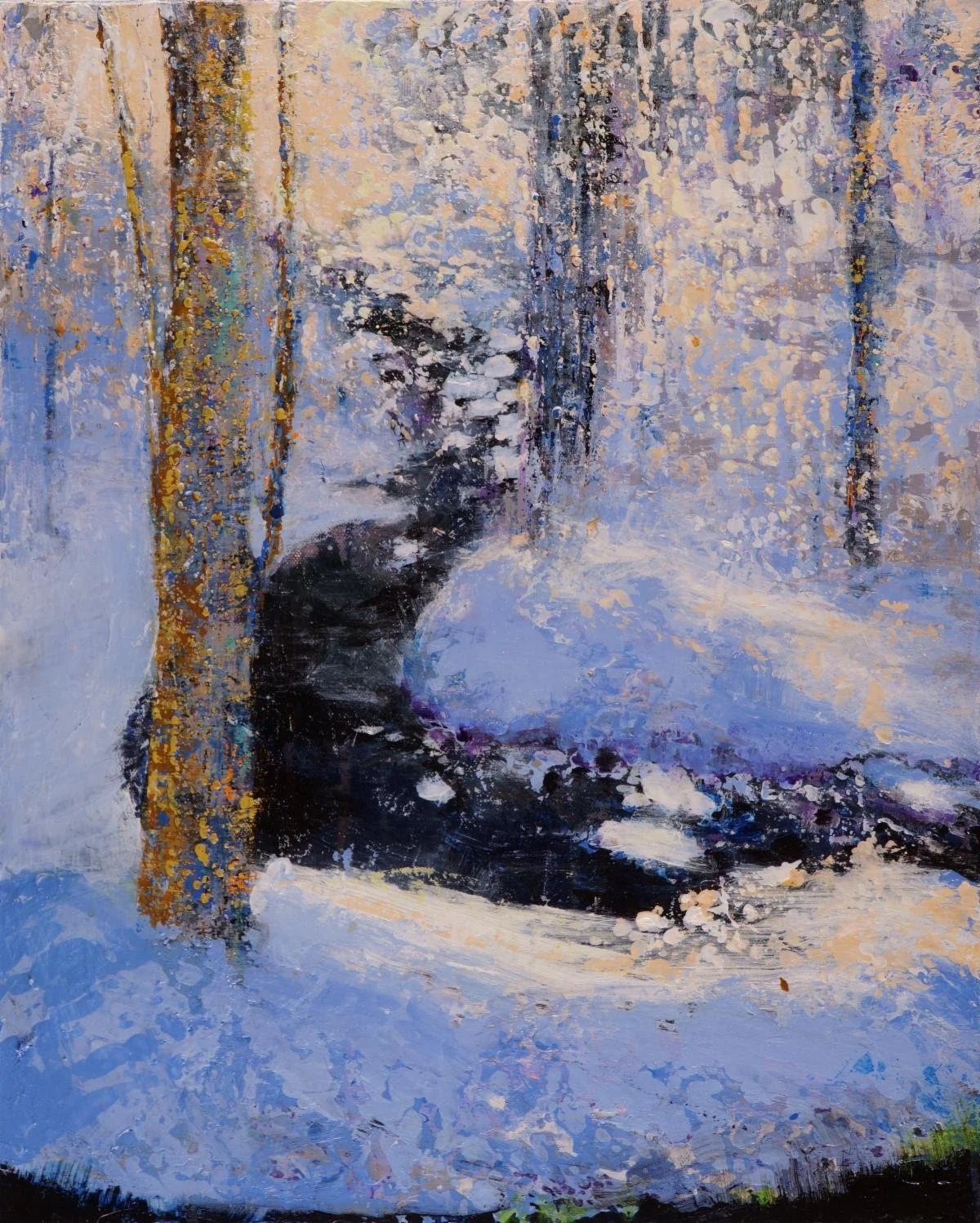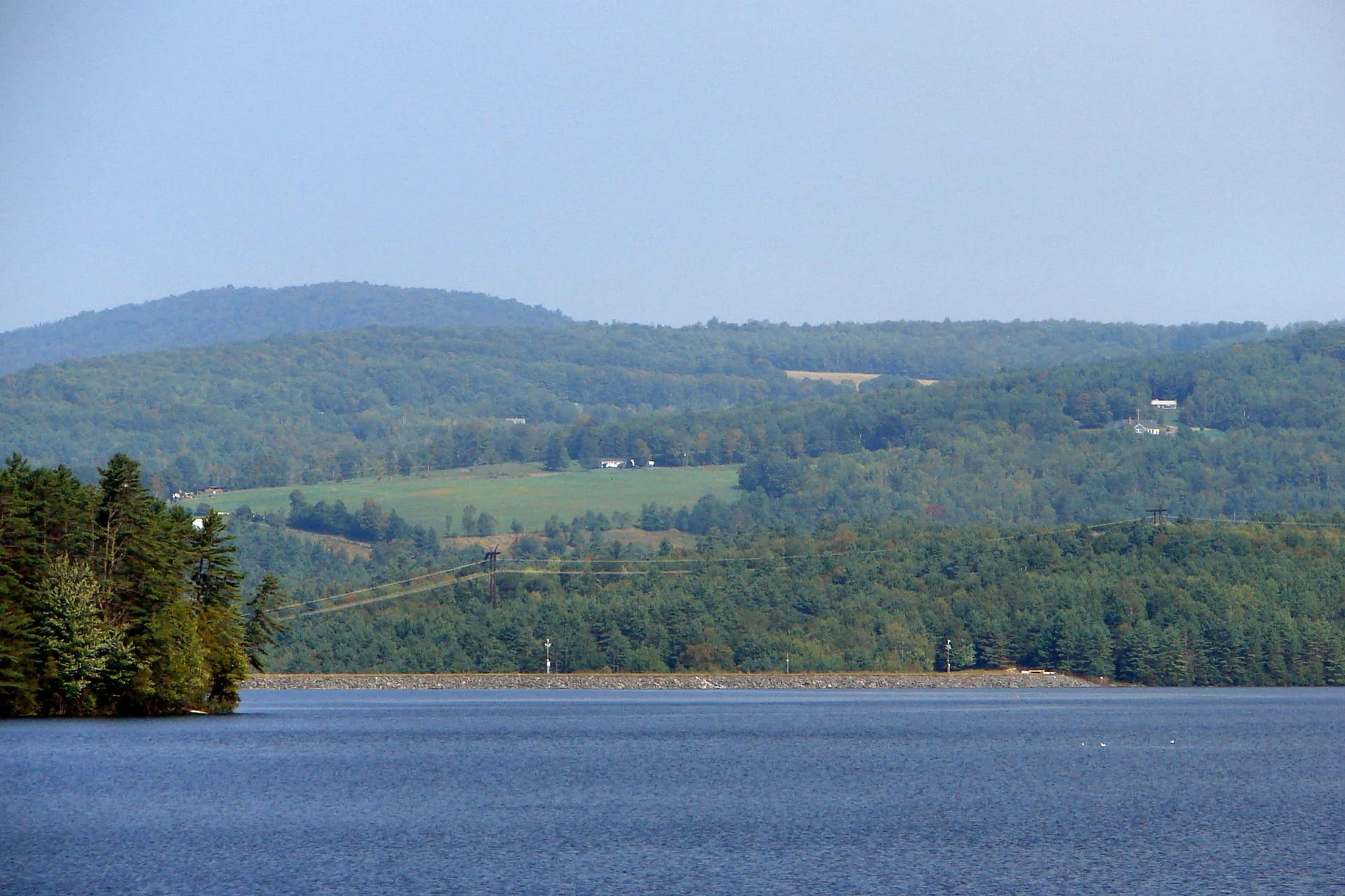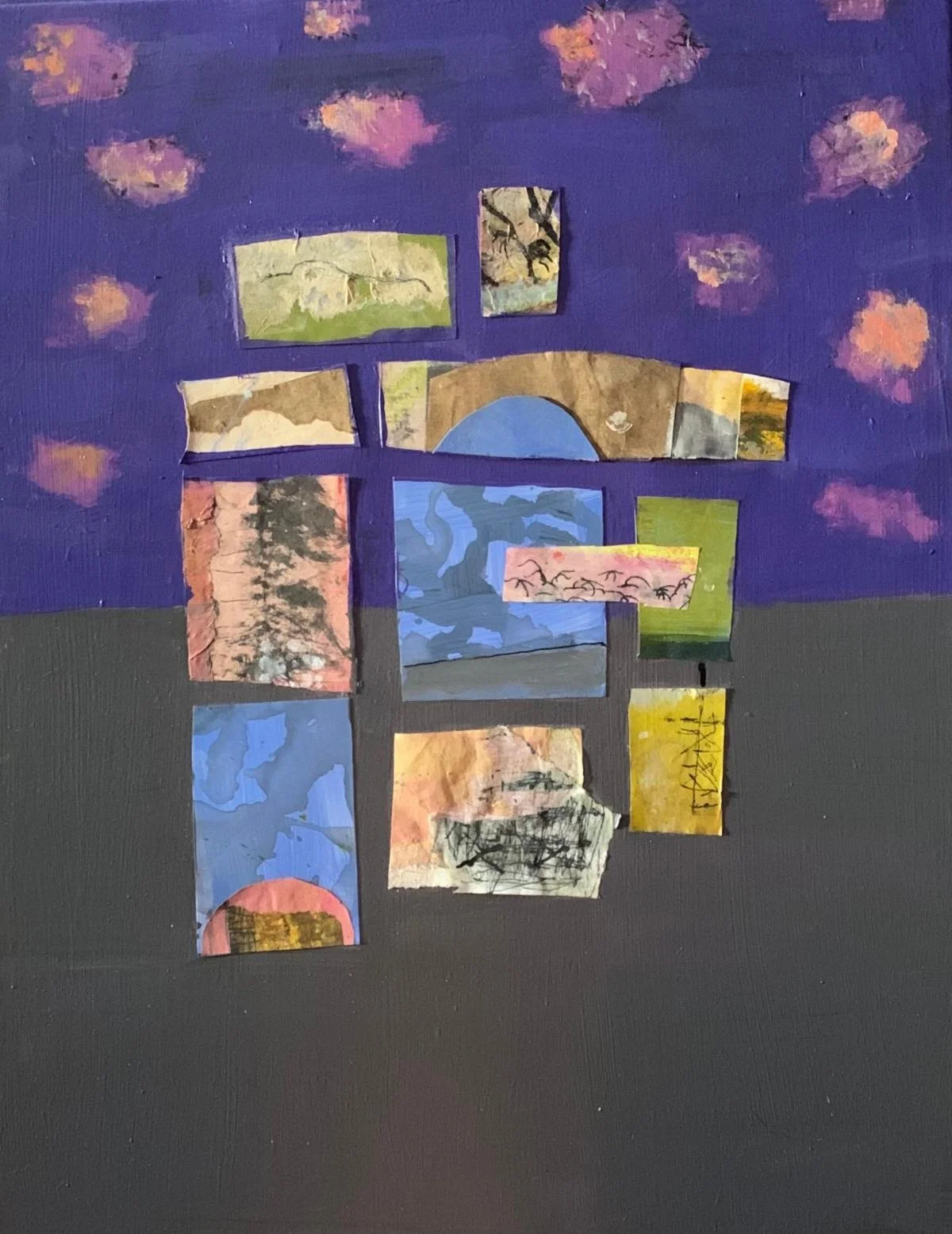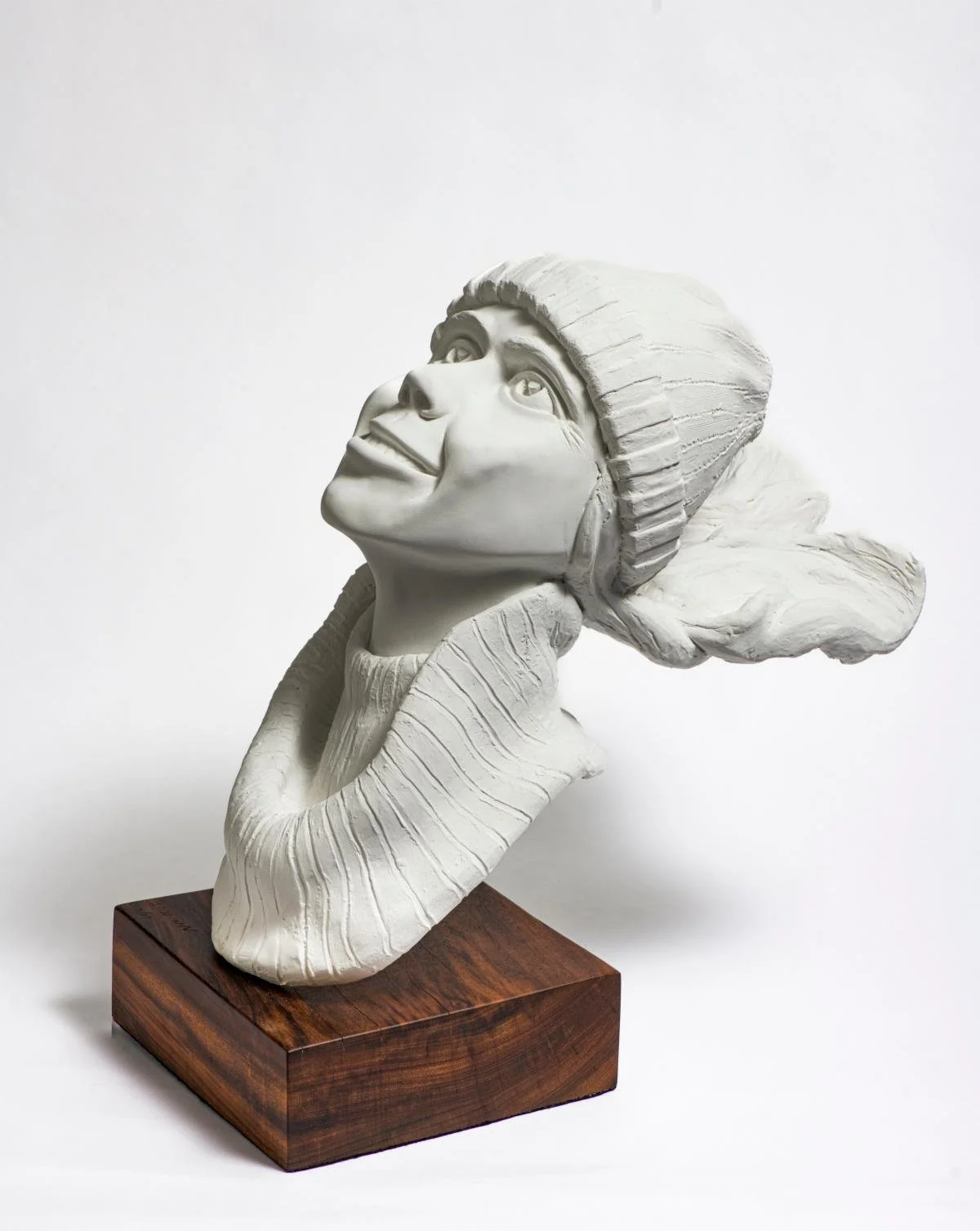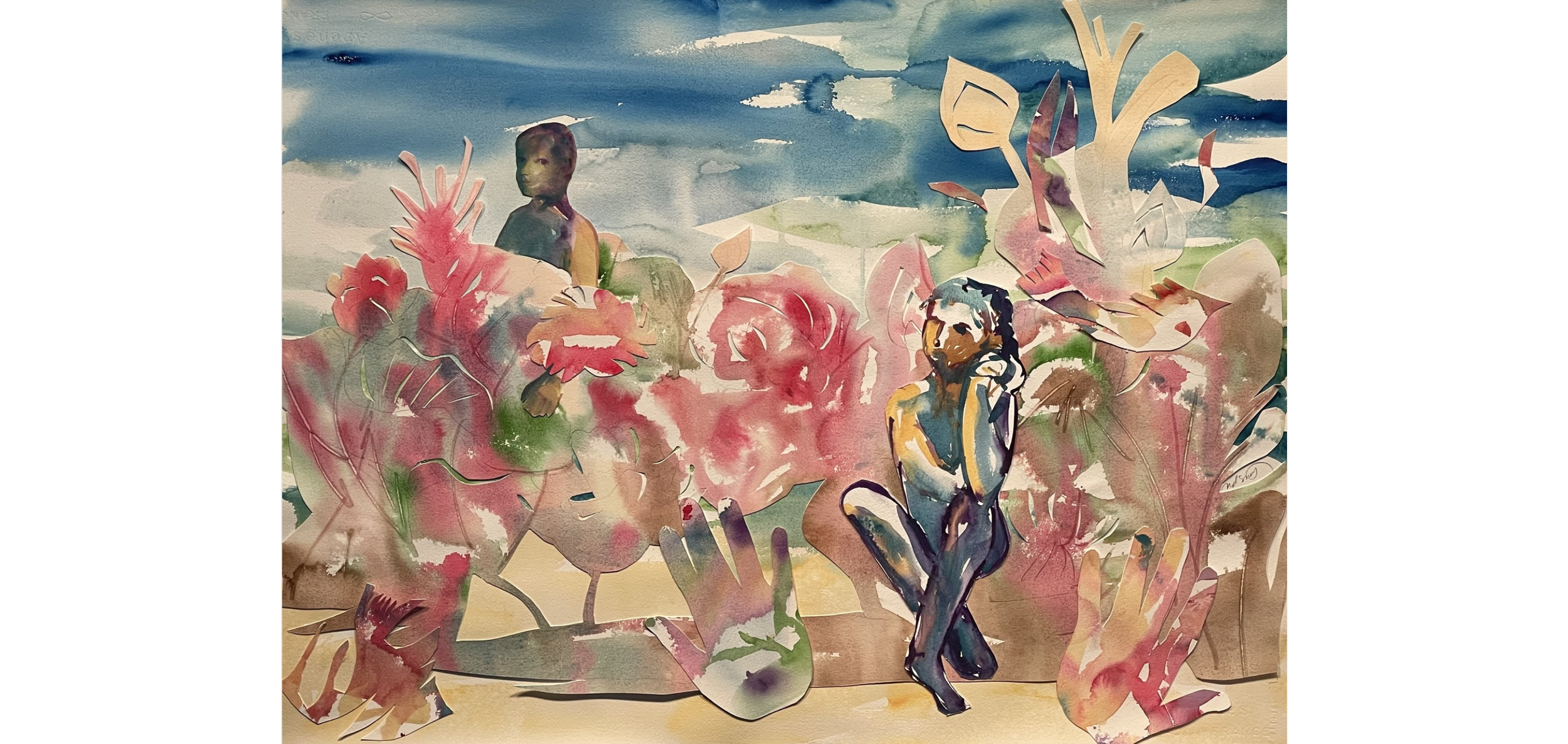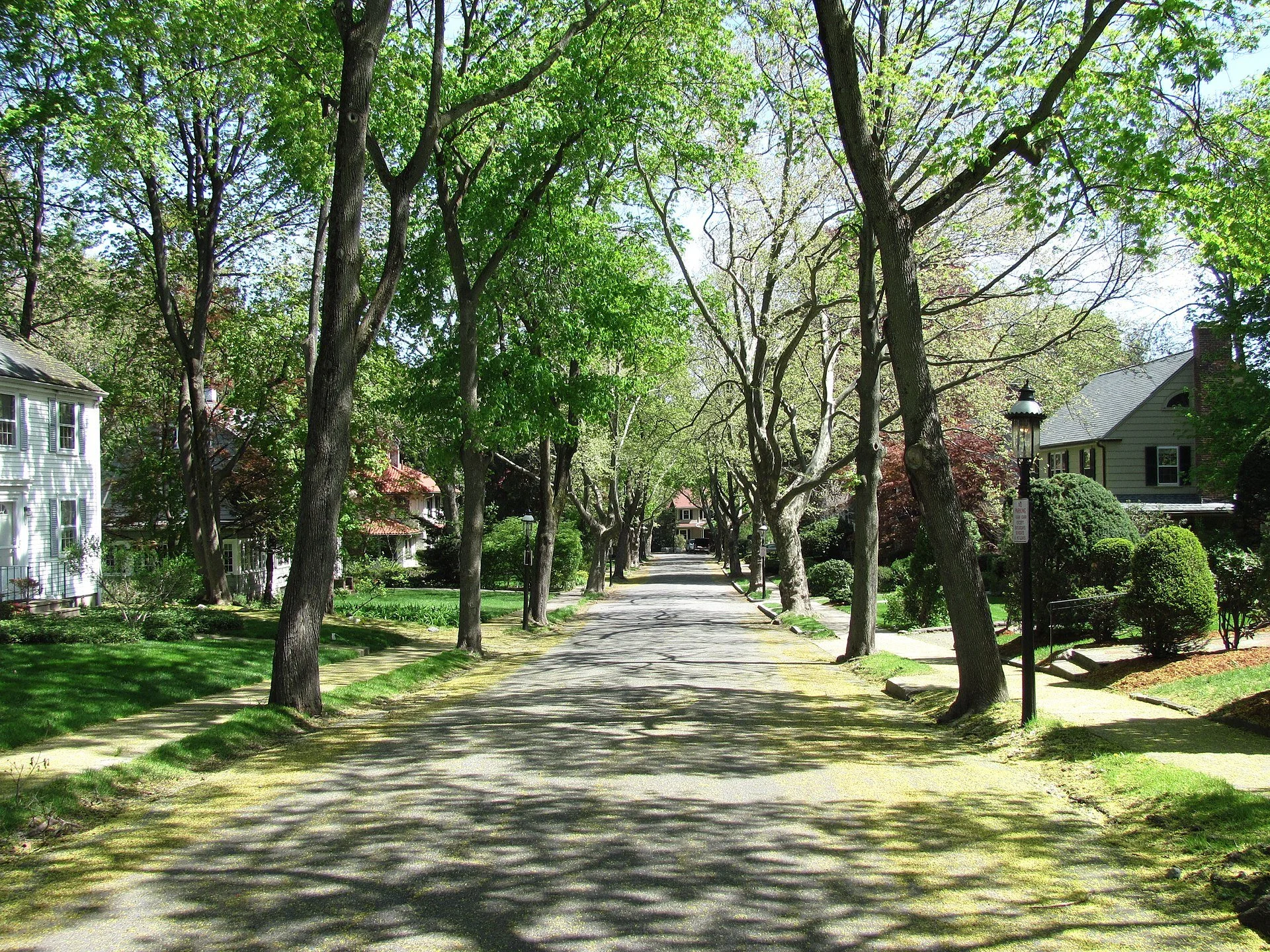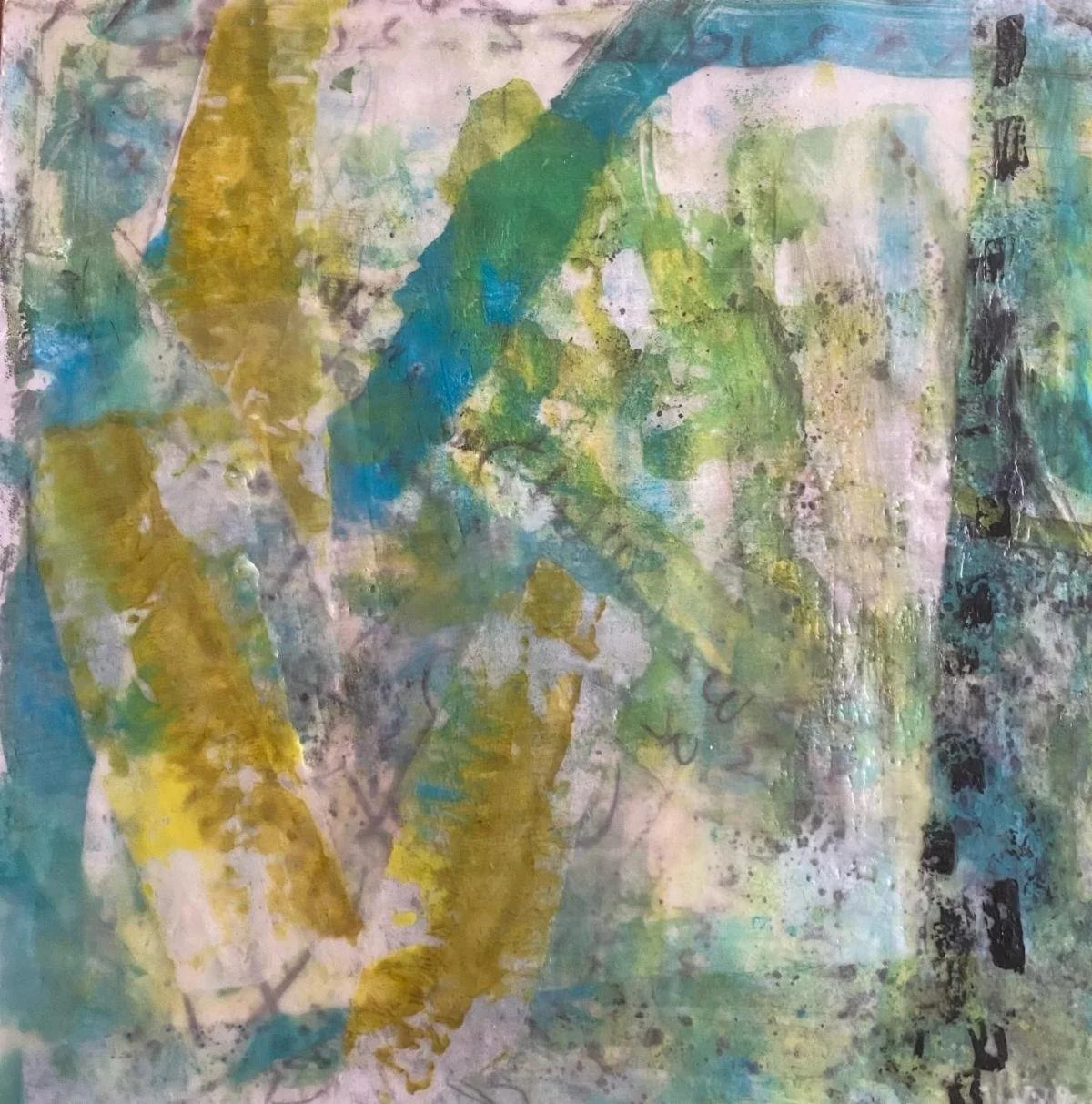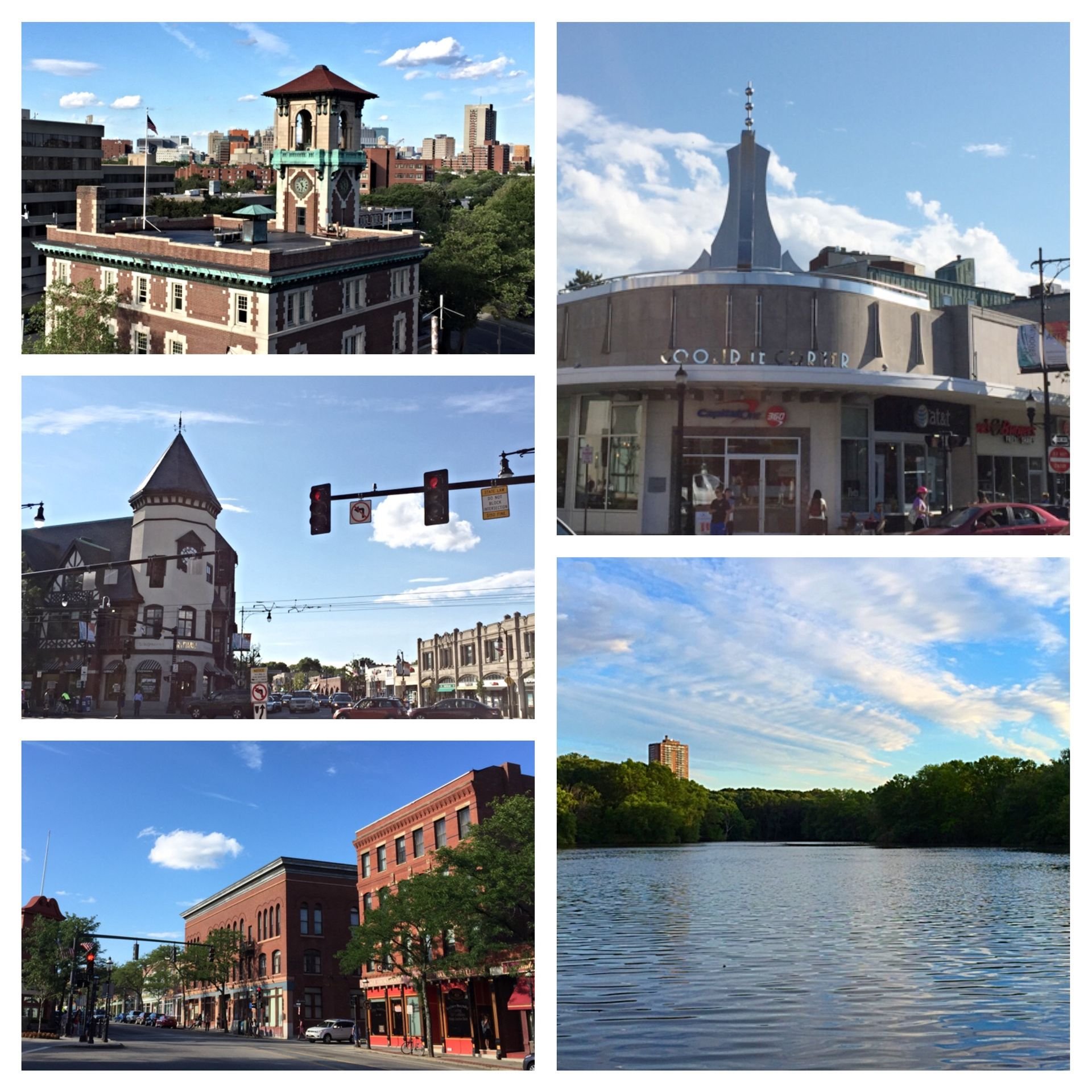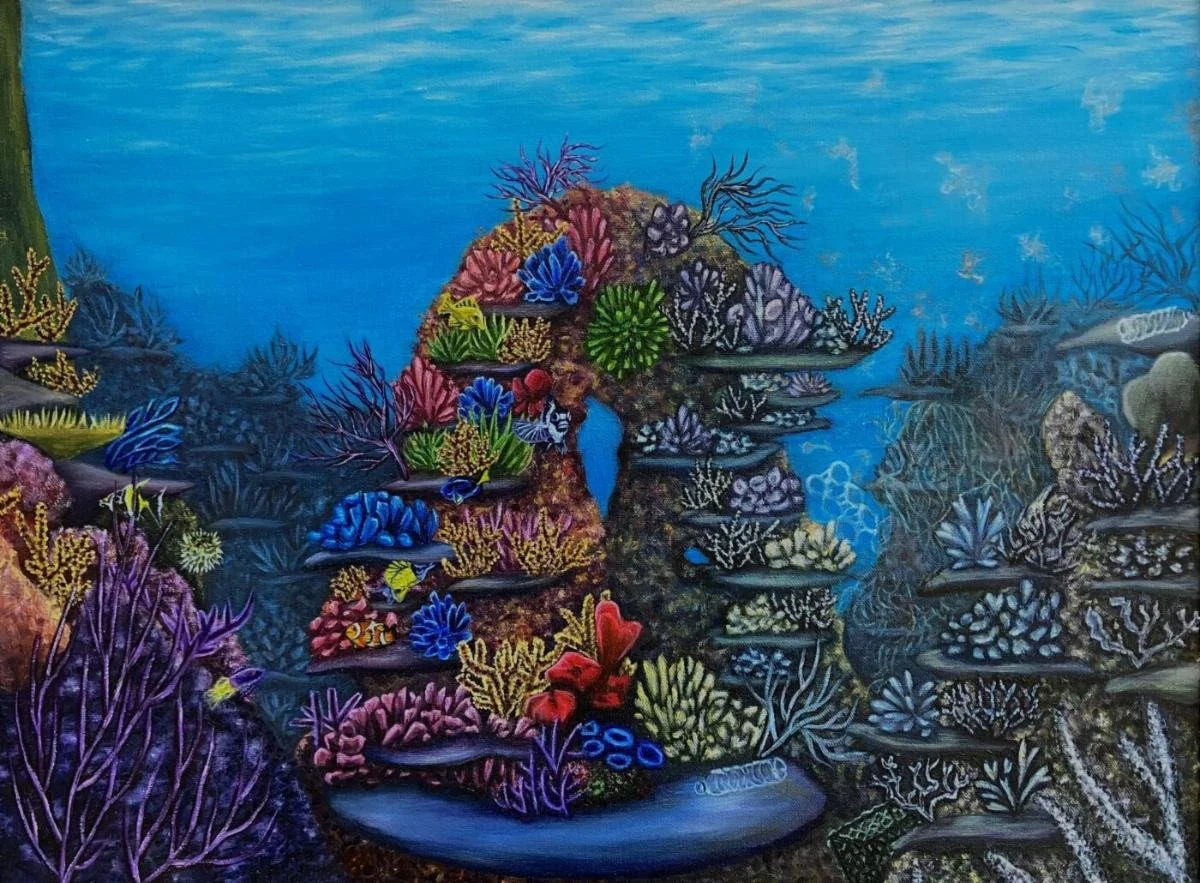
‘Meditations on the lost and found.’’
“Walden Pond” (wood, plastic, foam, chiffon and bolts), by Mark Jarzombek (born 1954), in his show “Recollection,’’ at Galatea Fine Art, Boston, through Sept. 2. He’s an MIT-based architectural historian and artist.
He says:
“I inject playfulness and energy into construction materials I collect from from building sites. The pieces, meditations on the lost and the found, are inspired by Impressionist paintings, baroque perspectival effects and color pallets derived from Indian temples.”
Site of Henry David Thoreau's (1817-1862) cabin on Walden Pond, in Concord, Mass.
— Photo by Percival Kestreltail
Walden Pond.
— Photo by Erik Granlund
Wash before eating
“Endowment” (archival digital print), in Newton, Mass.-based photographer Francine Zaslow’s show “Elements,’’ at Galatea Fine Art, Boston, through Sept. 1.
She says:
“As a still-life photographer, my tabletop becomes a stage for a wide but diverse collection of props.
Transposing elements with light and an unbridled honesty, I want to show every detail, both raw and unveiled.
My images explore a wide range of texture and forms, often employing unique found objects that transport the viewer to other worlds, unknown places in time, echoing a story told, a memory saved.’’
Don't go out in public without it
“La Commedia: Juliet's Mask” (cotton yarn, acrylic paint resin), by Anna Fubini, in her show “Unraveled Realities,’’ at Galatea Fine Art, Boston, July 5-July 28.
The gallery says:
“‘Unraveled Realities’ is a collection of fiber art and mixed-media works, including collaborative pieces and projects with fellow visual and performing artists. At its core, ‘Unraveled Realities ‘seeks to disrupt traditional narratives of canonical art and challenge the notion of a fixed nature of being, asserting the inherent dualities present in all things. The works showcase the interplay between materials, the creative process, and the thematic approach, embodying the concepts of deconstruction and reconstruction.’’
'Deconstructing and rebuilding'
“Heart Relic” (conte and charcoal on paper, fabric, thread, found wood, soil), by Luba Shapiro Grenader, in her show “Lament & Renewal: Restringing the Heart, Reviving the Self,’’ at Galatea Fine Art, Boston, July 5-28.
The artist, based on the Massachusets North Shore and an immigrant from Russia, says:
“This work is a contemplation on personal loss and global change. Seeing those close to me suffer through illness and pain is excruciating; global suffering echoes this personal grief. While I find beauty in the act of drawing, I find solace in deconstructing and rebuilding. Threads make connections between the drawn elements and beyond – connecting the physical and ethereal. Cloth reimagines the drawings by mending the forms and extending the images.’’
'Reflection of the presence of time'
“Untitled” (various media on panel), by Cambridge, Mass.-based George Shaw, in his current show, “Architecture of Time,’’ at Galatea Fine Art, Boston.
Mr. Shaw says:
“Architecture has always fascinated me because of its presence and how it modifies our experience of place and time. The pieces in this show are a reflection of this and are intended to be a meditation on objects as a reflection of the presence of time. Time is essential to our sense of being, yet it is intangible and only manifests itself in our memories and objects.’’
Stuck on the seas
“The Flying Dutchman,’’ by James Cole, in his show at Galatea Fine Art, Boston, through March 30.
Savoring ‘in-between times’
“Late Frost, Pines” (oil on panel), by Christina Beecher, in her show “Quiet Thaw,’’ at Galatea Fine Art, Boston.
“The transition from one season to the next is often overlooked and under-appreciated. Many of us tend to look forward to the warmth of summer, or the beginning of fall … all the while hurrying these changes and transitions in anticipation of what comes next. For me, the seasonal ‘in between’ times, particularly the unfreezing of winter ahead of the regrowth of spring, is of great interest. My goal in these works is to point out these ‘in between’ times as opportunities for calm reflection and quiet serenity.”
Magical materials
“Dreams of Spring,’’ by Pat McSweeney, in the show “Greater Than the Sum of Its Parts,’’ at Galatea Fine Art, Boston, through Aug. 27. The artist is based in the Charlestown section of Boston.
The gallery says the show features the work of fiber artists who "create new visions" by "reinventing old techniques." The artists use "fabric, thread, wool, reeds, paper, wire and even plastic to create magic.’’
The way they look in memory
“Considering the Course of Events’’ (acrylic, ink and graphite), by Chestnut Hill-based artist Norman Finn, in his show “Faces Along the Way: Real and Imaginary,’’ at Galatea Fine Art, Boston, June 20-July 2.
He explains:
“I have tried to convey through the canvas some of the individuals that made lasting impressions as well as triggering my imagination. The paintings represent images from my childhood and my extensive travels throughout the world.
“A group within the collection are done with a technique I call ‘Modular Art,’ which are pieces applied to the canvas that creat.e dimension to the composition. These painting are more in the realm of the imagination with an interesting color palette. Painting this collection enabled me to relive some of the forgotten relationships and fond memories.”
Sunset at Hammond Pond in Chestnut Hill
— Photo by NewtonCourt
Wave art
“Wave” (digital photograph), by Cape Cod-based artist Mary Doering, in the National Association of Women Artists’ group show “Contrast,’’ at Galatea Fine Art, Boston, May 5-28.
Wave action at the Cape Cod National Seashore
‘Exaltation of the domestic’
“Anatolia’’ (watercolor), by Randolph, Mass.-based Annee Spileos Scott, in her show “Mapping My DNA,’’ at Galatea Fine Art, Boston, April 7-30.
She told the gallery:
"I have always been drawn to the ancient civilizations of Eurasia,
reveling in the brilliant colors and obsessive patterning. I was not
yet cognizant of the fact that many of them are in my DNA.
During the lockdown, I was encircled by family heirlooms and
souvenirs of my global travels from many of these cultural
destinations. Still lifes, inspired by these precious objects and the
results of my DNA testing, converged into metaphors for my
ancestral roots. The process of creating these paintings provided
beauty and salvation from the dark outer world of the pandemic.
The work celebrates women, keepers of cultures and tradition.
The exaltation of the domestic, displayed in arrangements of both
opulent objects and those of the everyday, reveal history, memory,
and a sense of belonging to a long line of women in my ancestry.
National fruits and flowers were added as organic elements,
symbolizing the source of all life which inhabits each region.’’
A cabin of the Ponkapoag Camp (established in 1921), of the Appalachian Mountain Club, on the eastern shore of Ponkapoag Pond in Randolph. The camp has 20 cabins, dispersed across a wooded area, that typically each sleep 4-6 people. No electricity or potable water is available at the camp; untreated water may be taken from the pond. In the summer the camp also makes available a few tent sites for camping. It’s near Great Blue Hill, at 635 feet, the highest point in Greater Boston.
The flippers make Mass. housing crisis worse
“There Goes the Neighborhood (mixed-media installation), by Brookline-based Ronni Komarow, at Galatea Fine Art, Boston, March 2-April 2.
She explains:
"In 2021, business entities purchased nearly 6,600 single-family homes in Massachusetts, more than 9 percent of all single-family homes sold and nearly double the rate of such purchases a decade before. Investors and other businesses...spent more than $5.6 billion in Massachusetts purchasing these properties, the majority in cash, to rent or flip as the state’s housing market rises.
“Investors are spurred by high demand for housing, rising rents and soaring home values, making it a lucrative business. But housing advocates say the trend is making it harder for individual homeowners to buy and driving up rents, so renters get priced out….
“As an advocate for historic preservation in Boston, I'm mindful that many of these would-be buyers would demolish a purchased home quickly and replace it with the largest, cheapest structure possible, to be sold at the greatest profit. None of these would-be buyers live in the city or have any interest in neighborhoods, community preservation, or quality of life for local residents.’’
Notating the landscape
“Winter Rill” (acrylic on canvas), by Anni Lorenzini, in her show “In Sight: Notating the Landscape,’’ at Galatea Fine Art, Boston, Feb. 3-26. She lives part of the year Waterford, Vt.
She writes:
"'All I could see from where I stood...' Here poet Edna St. Vincent Millay pinpoints the artists' charge; to paint what you see as you see it.
“I notate the landscape with random strokes, smears and smudges. These tangled dots develop into intricate patterns that form the earth and sky. I respond to the intimate structure of each landscape painting as I learn to paint with my chosen tools.
“I apply paint with everyday household tools like sponges, rags and squeegees. These tools come from my life, providing an authentic means for artistic expression as I live on this fragile and beautiful earth."
Waterford, Vt., seen across Moore Reservoir
— Photo by P199
Adjust your attitude
“Better Times” (mixed media), by Susan Leskin, in the group members show at Galatea Fine Art, Boston, Jan. 13-29.
"It feels important right now to find and express visions of hope and lightness to counter the despair that many of us feel about the current state of the world. These collages reflect those visions for me."
Her artist statement says:
“My work frequently explores connectivity and disjunction. I enjoy creating images that are ambiguous and may be just on the edge of recognition. There is often a focus - explicit or implied - on the relationship between humans and nature.
”I use fluid acrylic paint and mediums, ink, pencil, and painted papers in my collages.’’
‘Realistic memories’ and dreams
“In Winter” (cast resin), by Memy Ish-Shalom, in his show “Dreams and Memories, ‘‘ at Galatea Fine Art, Boston, Dec. 2-Jan. 8. He’s an immigrant from Israel now living in Newton, Mass.
He says:
“My sculptures are an artistic response to realistic memories and to dreams or daydreams. But sometimes dreams turn into memories and memories become dreams.
“I reflect on childhood memories of being a son to my father and adult memories of being a father to my son. I also reflect on the deep sorrow that grew from losing my father.’’
Before eating the apple
“Eden’s Color-Full Inhabitants” (watercolor) by West Newton, Mass.-based Nancy DuVergne Smith, in her show “Skins and Petals: Living Color,’’ at Galatea Fine Art, Boston, Dec. 2-Jan. 8.
She says:
“My paintings involve vibrant things—water, plants, and people—in the magic of watercolor. This medium meshes rich colors and the flow of water to create a living entity that mingles and changes as it dries. Each painting is a conversation with time and intention. Art like this invites us to return, reconsider, and refresh.’’
Windermere Road, in affluent West Newton, a suburban Eden.
— Photo by John Phelan
Art from Alzheimer’s
“Axial 1” (acrylic on canvas), by Lowell, Mass.-based Diana Zipeto, in her show “Resonance,’’ at Galatea Fine Art, Boston, Dec. 2-Jan. 8
She tells the gallery:
"An MRI machine creates images by sending out signals that the body's cells respond to. The map of these responses offers an impossible view, allowing doctors and scientists to see, diagnose and understand the body.
“The paintings in this exhibit are based on the MRI scans that led to my father's Alzheimer's diagnosis. This ongoing project has given me an opportunity to learn from scientists and neurologists about Alzheimer's and MRI, and provided a way for me to try to navigate this disease that profoundly affects so many families, now including my own.
“The ability of science to look inside for answers and the wish to do so is something my father, as a scientist and engineer, has always believed in. As an artist and creator, I have believed in something similar. The view you get will not provide all the answers or necessary cures, but there is a beauty in the asking."
The balm of blue
“I Have Loved Many Colors” (encaustic monoprint), by Brookline, Mass.-based Lola Baltzell, in her show ‘Dabbling in Blue Magic,’’ at Galatea Fine Art, Boston, Nov. 4-27.
She tells the gallery:
"One of my favorite authors is {the late novelist}Vladimir Nabokov, and the title of this show is a nod to his imagery. One remarkable thing about his writing is that English is his second language. He refers to color frequently, my true love language.
Blue. Why Blue Magic?
All the work in this show is encaustic, also known as hot wax, and includes collage, painting and monoprints. I don't typically work in blue, yet all the pieces in this show are blue. I've spent a lot of the pandemic in the water - metaphorically and literally. Feeling adrift, lost at sea, looking for terra firma, yet I sought solace on the water, spending as much time paddleboarding as possible. Working in blue has felt like a balm, soothing, healing. My own blue period."
Views of Brookline
Photo collage by Ddogas
Coral crisis; failed colony
“Bleached” {by ocean acidification?} (oil on canvas), by Weymouth, Mass.-based Elysia Johnson, in the New England Collective XII show at Galatea Fine Art, Boston, Aug. 5-28.
Weymouth City Hall, built in 1928 and modeled after the Old State House in Boston, built in 1713.
Weymouth was settled by the English in 1622 as the Wessagusset Colony. That was before Boston (founded in1630) was established by the Puritans and after Plymouth (founded in 1620) was founded by the Pilgrims. The Wessagusset Colony was led by Thomas Weston, who had been a major financial backer of the Plymouth Colony. But the settlement was a failure because the 60 men from London who settled it were ill-prepared for the climate and other hardships there. Further, they lacked the religious drive of the Pilgrims. Wessagusset was founded on purely economic grounds and the 50-60 men there didn’t bring their families.
Bichman House, c. 1650, is likely the oldest surviving house in Weymouth though it looks rather like a modest suburban ranch house.
— Photo by Swampyank
Soothing with silk
“Imitating Symmetry” (silk), by Boston artist Evan Rosenberg, in his show “Mantra,’’ at Galatea Fine Art, Boston, through July 31.
He tells the gallery:
"My work utilizes silk as a medium to capture, interpret and cope with the chaotic and uncontrollable realities of the world around me. My interest in this material was born out of my research at a biotech startup, which uses silk protein to stabilize vaccines. Intrigued by the possibilities of silk as a material for art, I began exploring its properties and limitations by weaving it into three-dimensional spaces.
“The work I do is grounded in repetition and meditation. As I create, I am driven deeply into self-reflection and meditation. I use the work to disconnect from my thoughts and impulses and guide me into a flow state.’’
Nonotuck Silk Co. advertisement for Corticelli silk showing the stages of silk production.
Nonotuck Silk Company (1832-1930 in various incarnations) produced silk thread at a mill in Haydenville, Mass. It was established as the North Hampton Silk Company and operated for years by members of a utopian society active in abolitionism. The company later acquired the Corticelli Silk Mills, in Leeds, Mass., and became the Corticelli Silk Co.
